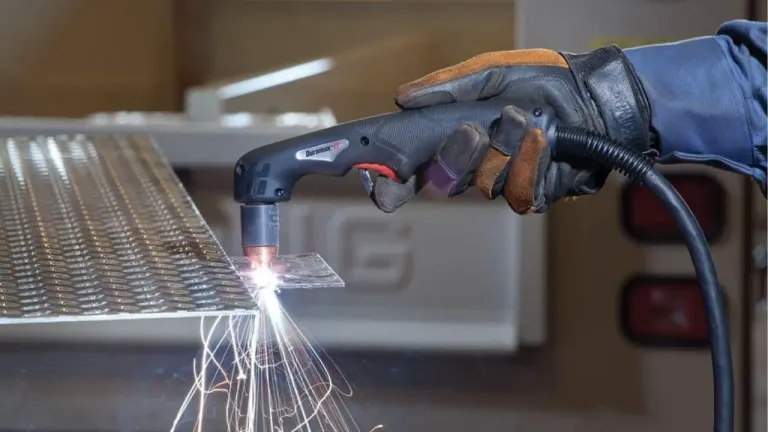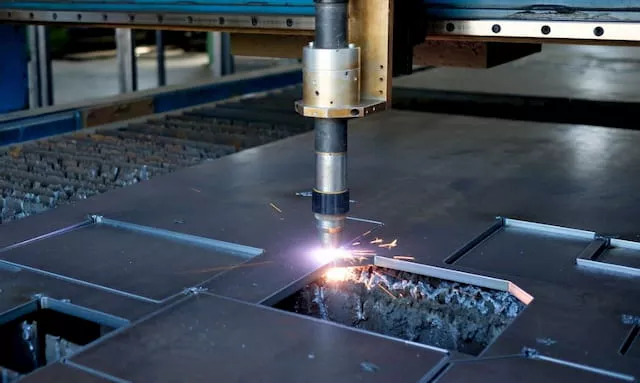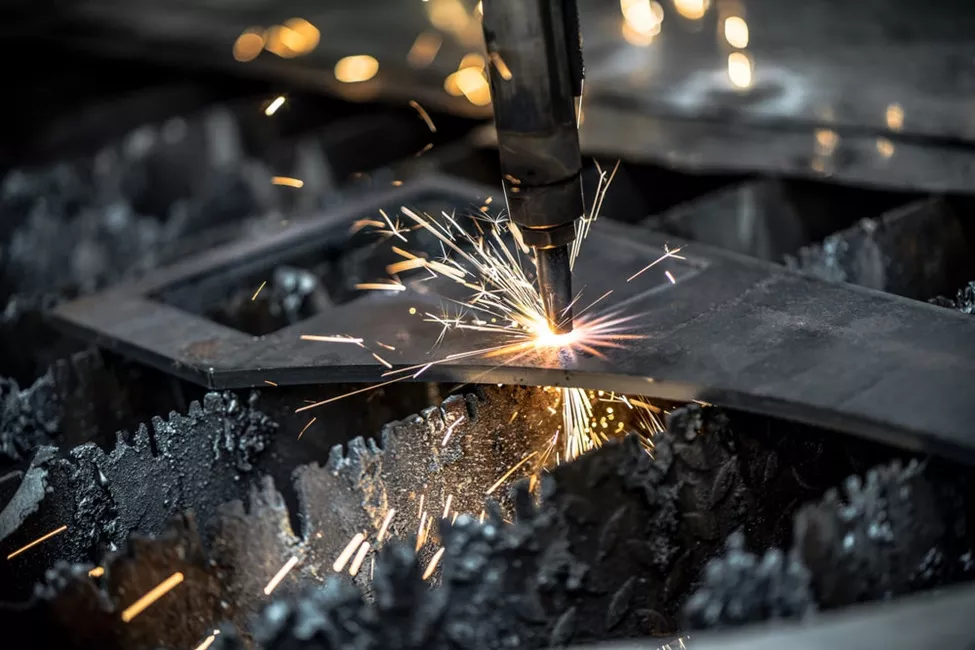Most metal fabrication shops require plasma cutters to process metal parts. This stems from the fact that modern industry relies on metals and alloys to make the tools needed for everyday business because products made from metal are so solid and durable. For example, precision forming technology makes a variety of industrial machines, automobiles, robots, drones, aircraft, and military-related products.
To manufacture complex metal products, the problem of how to cut and manipulate them precisely becomes the primary solution. In most cases, the preferred option is plasma cutting. This standard tool, which has been around since the early 1900s, may sound old in technology but it is very reliable.
So what is plasma cutting? How does it perform its work? What are its advantages? How many types are there? Read on as this article provides detailed answers to questions about plasma cutting. It can also be used as a guide for scientific applications.
What is plasma cutting?
Want to learn about plasma cutting? First, you need to understand what plasma is. I’m sure you’ve studied the matter, which has three basic forms-solid, liquid, and gas. Plasma is also a form of matter. It exists mainly in the upper layers of the Earth’s atmosphere. The most well-known plasma in nature would be the aurora borealis, a feature caused by the solar wind made of plasma.
Plasma cutting uses an excited gas to the point where the electrons are separated from the atoms but still move with the nucleus. This gas is converted into plasma by intense destructive heating, so the plasma is also commonly referred to as an ionized gas.
Plasma cutting uses this gas to form a contour-cutting technique. This metal fabrication process uses ionized gas heated to temperatures above 20,000°C to melt the metal material. This gas is ejected at high pressure, melting the material and removing it from the cut. This technology can cut any conductive metal, steel, aluminum, brass, titanium, copper, and other metals of varying thickness. Plasma-cutting technology is more cost-effective than other cutting technologies when cutting thick metals. It has a wide range of applications, low tool maintenance costs, high cutting accuracy, and is suitable for cutting parts with complex geometries.
You’ve gotten an initial idea of plasma cutting technology; now, let’s learn a little about its history.

Types of plasma cutting
Current plasma cutting systems are divided into conventional and precision plasma systems.
Conventional plasma system
Usually, shop air is used as the plasma gas, and the torch’s nozzle determines the arc’s shape. Handheld systems fall into conventional plasma systems and applications where the material being cut has low tolerances. While these types are common, other forms of plasma cutting are more accurate. Traditional plasma systems contain the following two plasma cutting processes.
Air plasma. Air plasma systems were initially designed for handheld cutting and use primarily compressed air as plasma gas, which is relatively simple and inexpensive. They have power level outputs as low as 12 amps and can cut up to 1⁄8 in. up to 125 amps, with a cutting capacity of 1-1/2 in. These systems primarily use inverter power technology, so they are easily portable.
Conventional mechanized plasma. This type of plasma system uses a single gas (air or oxygen) and is only suitable for torches mounted on the machine. In addition, when used in modern CNC cutting machine applications, they often have more sophisticated interfaces to provide better performance. Traditional mechanized plasma systems range from 130 amps to as much as 1,000 amps.
Precision Plasma Systems
Precision plasma systems primarily use oxygen, nitrogen, or a mixture of hydrogen/argon/nitrogen to achieve high-precision cutting on various conductive materials. This system has a CNC for precision control of the plasma to achieve the most accurate cuts. The torch and amount are more complex in design, and the arc is compressed to increase accuracy. High-precision plasma cutting systems typically include the following two processes.
High Definition Plasma. High-yield sheet and plate cutting is the area of most significant interest in process development. Since its introduction in the early 1990s, the HD plasma-cutting process has made tremendous strides in quality, speed, power levels, operating costs, and, more recently, ease of use. In HD plasma cutting, the plasma arc is forced through a smaller nozzle orifice, taking full advantage of the laws of high-temperature physics. This results in cleaner, squarer cutting edges than air and conventional plasma cutting while maintaining acceptable wear part life in the torch. Today’s HD plasma systems range from 130 to 800 amps and can cut from 26 ga. Up to 3 inches on carbon steel and 6-1⁄4 inches on stainless steel and aluminum.
Ultra HD plasma. This type of plasma, called X-Definition, produces consistent results in ISO Range 2 and extended ISP Range 3 when cutting mild steel compared to conventional HD plasma. Based on ISO 9013, an international standard that defines the quality of thermally cut parts from 1 to 5, with Range 1 is considered the best, UHD plasma can cut thin steel in ISO Range 2 at low current settings.
Those cutting thicker mild steel (3/4″ thick) will generally achieve ISO Range 3 cut quality throughout the life cycle of the consumable part. These cut-quality improvements cover all metal types, including aluminum and stainless steel.
How Plasma Cutting Machines Work
Depending on the application, plasma-cutting machines have been born in various shapes and sizes. Some giant machines use robotic arms to make precise cuts and compact handheld machines. Regardless of the variations in machine shape, all plasma cutting is designed around the same appearance principles.
A plasma cutter delivers a pressurized gas such as nitrogen, argon, or oxygen through a small tube, allowing an ultra-high speed hot plasma jet to pass through conductive metal to cut it. The work is mainly done by energizing the negative electrode, and then the tip of the nozzle touches the metal to form a circuit, thus creating a powerful spark between the electrode and the metal. As the inert gas passes through the small tube, the sparks heat the gas to a temperature of 30,000 F (16,649 C) and move at 20,000 feet per second (6,096 m/s), creating a directed plasma stream. The high-temperature, high-speed plasma stream melts the metal into slag for cutting purposes.
The plasma is electrically conductive, and the entire cycle is continuous as long as the electrodes are continuously powered and the plasma remains in contact with the metal being cut. In addition, the radius of the plasma beam is effectively controlled, usually by designing a second set of channels in the cutting nozzle, which release a constant airflow around the cutting area to protect the kerf from oxidation and to confine the plasma beam.
Plasma technology is safer than other cutting processes for cutting metals, which is why it is so prevalent in the marketplace.

Why use plasma?
Please read the article; a good understanding of the plasma cutting process and its principles exists. You may still wonder which process you should choose for your parts in deciding which cutting method to use. The easiest way is to select a professional cutting service provider. For example, we at Elimold are a company that specializes in custom plastic or metal parts.
When picking a cutting and manufacturing process, the most important thing to consider is the thickness of the material you want to cut, the desired edge quality, productivity, cost, etc. That one has the most impact and is more critical to the project.
The most significant difference between plasma cutting and other cutting processes is time and cost. Especially when dealing with thicker materials. In comparison, waterjet cutting and laser cutting are very costly. At current market pricing, waterjet cutting costs three times as much as plasma cutting, and laser cutting costs up to eight times as much. In addition to better production costs and efficiency than other processes, it is accurate enough to cut any shape.
If this turns out not to be everything you wanted to know and more, please get in touch with us, and we will be happy to discuss more about how your business can take advantage of plasma cutting.
Conclusion
Please read this article to understand plasma cutting, including its advantages, how it works, and the popular plasma cutting systems on the market. Plasma cutting is a process that uses a fourth-stage substance to cut conductive metals. The process offers many advantages, including high productivity, versatility, accuracy, and surface quality.
Want plasma-cutting services? It would help if you had Elimold, one of the world’s leading providers of plasma cutting services, and other cutting services such as waterjet and laser cutting. We can provide fast delivery service and competitive pricing. Want to work with us? Contact us in the form below.

